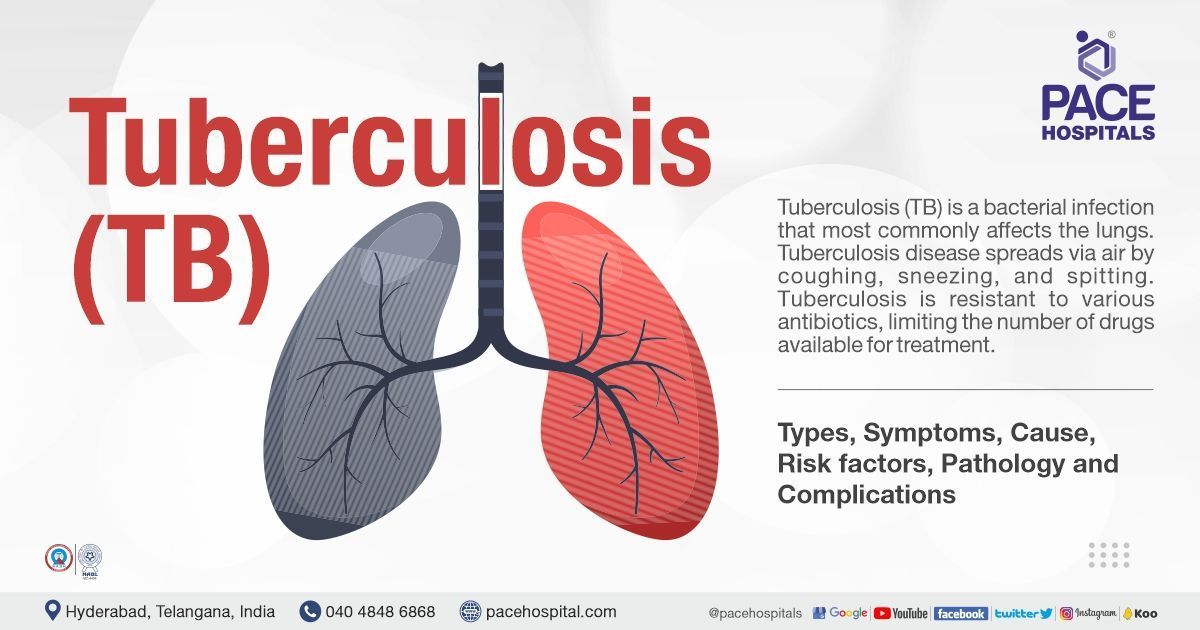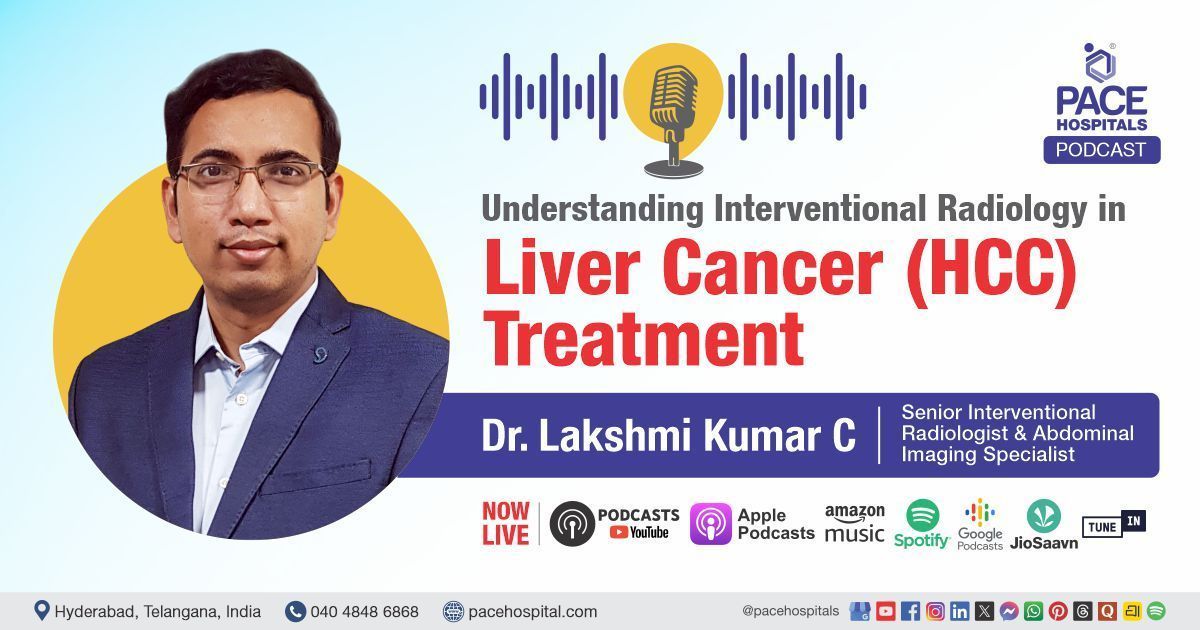Tuberculosis (TB) - Symptoms, Types, Causes, Risk factors & Prevention
Pace Hospitals
Tuberculosis definition
Tuberculosis is a bacterial infection that most commonly affects the lungs. TB disease spreads via the air by coughing, sneezing, and spitting. It is believed that around one-fourth of the worldwide population has been infected with tuberculosis.
Tuberculosis (TB) has been a major cause of suffering and death since time immemorial. Believed to be one of the oldest human diseases, the history of tuberculosis is at least as old as mankind. Over the years, tuberculosis's medical implications and social and economic impact have been enormous.
Tuberculosis is caused by Mycobacterium tuberculosis (Koch's bacillus) and is transmitted through the respiratory route. Only 10% of infected individuals develop active tuberculosis disease, while the rest successfully contain the infection in a latent state.
Epidemiology of Tuberculosis disease (TB)
Tuberculosis is still the world’s leading cause of death from an infectious disease despite 90 years of vaccination and 60 years of chemotherapy; the World Health Organization (WHO) reports around 1.04 crore new cases with 18 lakh deaths globally. Approximately one-third of these recent cases (about 30 lakhs) remain unknown, not receiving proper treatment.
The incidence of the disease combined with antibiotic resistance makes tuberculosis one of the most deadly diseases in the world, and to increase its awareness, World Tuberculosis Day has been commemorated annually on the 24th of March each year since 1982 initiated by the WHO honouring the centennial anniversary of Dr Koch’s discovery in finding the bacteria (Mycobacterium tuberculosis - causative agent of tuberculosis).
Brief History and Etymology of Tuberculosis
There have been references to this ancient scourge in the Vedas [vide infra], and it was called “rajayakshma” [meaning “wasting disease”]. Hippocrates [460-377 B.C.] called the disease “pthisis”, a Greek word which meant “to consume”, "to spit," and "to waste away “. The word “consumption” [derived from the Latin word “consumere”] has also been used to describe tuberculosis in English literature.
Tuberculosis Meaning
The word “tuberculosis” is a derivative of the Latin word "tubercula", which means "a small lump". Robert Koch discovered the infectious agent of Mycobacterium tuberculosis on the 24th of March, 1882.

Types of tuberculosis disease
Tuberculosis can be classified into different clinic-pathological types depending on various factors based on:
- The sequence of events following the first exposure
- Location
Three types of tuberculosis arise when the disease is classified according to the sequence of events following the first exposure, such as:
- Primary tuberculosis
- Progressive primary tuberculosis
- Post-primary tuberculosis
Primary tuberculosis - Occurs in persons exposed to Mycobacterium tuberculosis for the first time.
Progressive primary tuberculosis - Arises when there is impaired immunity. It is most commonly seen in infants, adolescents and the elderly.
Post-primary tuberculosis - Generally seen in adults due to endogenous reactivation or exogenous reinfection in a previously sensitised (infected and treated) patient who has retained some degree of acquired immunity.
Based on the location of the infection, two types of tuberculosis are seen, such as:
- Pulmonary tuberculosis
- Extrapulmonary tuberculosis
Pulmonary tuberculosis - tuberculosis is seen in the lungs
Extrapulmonary tuberculosis - Occurs in organ systems other than the lungs. The most common sites are lymph nodes, pleura, bone and joints, urogenital tract, and meninges.
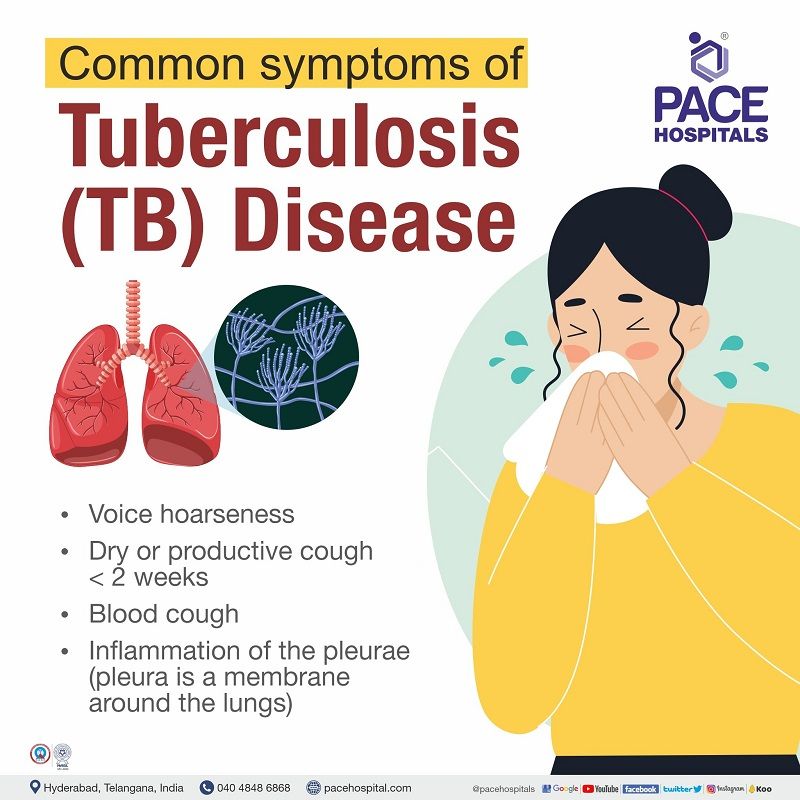
Tuberculosis - TB Symptoms
The sign and symptoms of tuberculosis (TB) can mimic many diseases. The patients develop symptoms insidiously, and some may remain asymptomatic - usually, patients with pulmonary TB present with constitutional and respiratory symptoms.
Constitutional symptoms include:
- Tiredness
- Headache
- Weight loss
- Fever (usually appears in the late afternoon/evening, is low-grade at the onset and becomes high-grade with the progression of the disease)
- Night sweats and
- Loss of appetite
Respiratory symptoms include:
- Voice hoarseness
- Dry or productive cough lasting more than 2 weeks
- Haemoptysis (the coughing up of blood) is often the presenting symptom
- Dull aching chest pain due to tuberculosis pleurisy (inflammation of the pleurae) or pneumothorax (air/gas trapped in the thoracic cavity), especially during inspiration
Clinical manifestations of tuberculosis in HIV-infected patients vary and generally depend upon the severity of immunosuppression. In the early stages of HIV, the clinical presentation of tuberculosis tends to simulate that observed in persons without immunodeficiency.
Risk Factors of Tuberculosis Disease (TB)
There are several predisposing factors which could increase the chances of contracting tuberculosis. The risk factors include:
- Diabetes mellitus – Diabetics are at 2.44-8.33 times higher risk of developing tuberculosis. Active tuberculosis evolves most frequently in patients with poor glycemic control. Approximately 15% of global tuberculosis cases could be from diabetes.
- Smoking – Globally, most tuberculosis patients live in underdeveloped or developing countries, with high tobacco consumption. Smoking leads to ciliary dysfunction and decreased immune responses, which increases the susceptibility to tuberculosis. Risk of death due to tuberculosis is 9 times higher for smokers. Both passive and active smokers are connected with an increased risk of tuberculosis.
- Alcoholism - Approximately 10% of tuberculosis cases are attributable to alcoholism. Alcohol abuse influences the incidence of tuberculosis, its clinical evolution as well as its outcome. Alcohol consumption (≥ 2 drinks per day) was associated with an increased risk of tuberculosis when accompanied by smoking.
- Illicit drug use – It is a significant public health problem, and cocaine is the most common one. It can induce various pulmonary problems, of which tuberculosis is one.
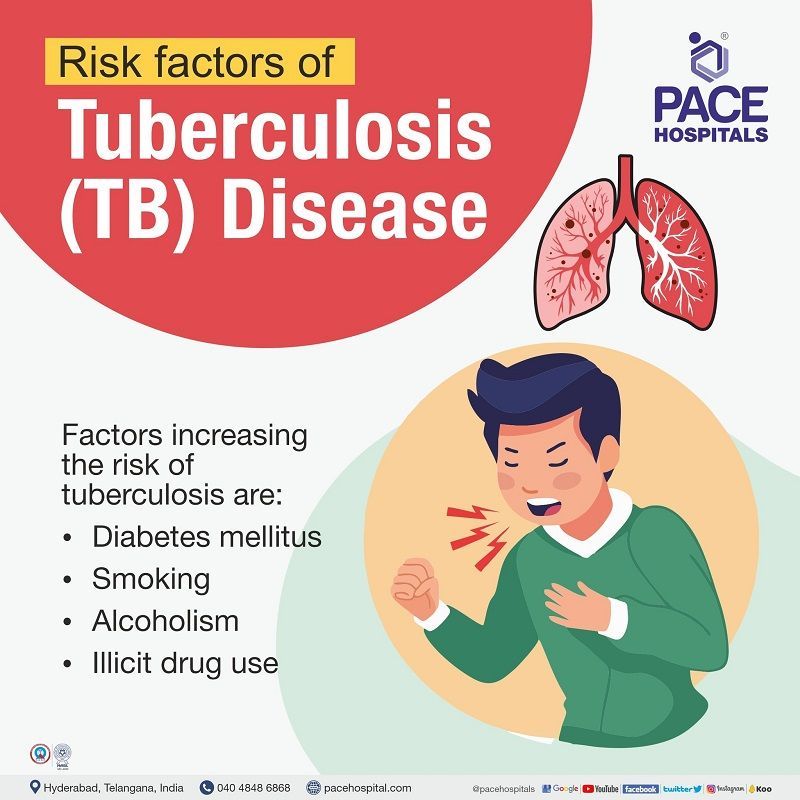
TB - Tuberculosis Causes
The bacteria that cause tuberculosis is Mycobacterium tuberculosis (Koch's bacillus). Tuberculosis (TB) is communicable through the air when an infected person coughs or sneezes.
TB is not as virulent as the cold or flu and typically requires prolonged close contact with an infected person to spread. Not everyone with tuberculosis is infectious, and people with extrapulmonary tuberculosis do not spread the infection.
Contact with contaminated surfaces or objects is unlikely to spread the disease. Untreated active pulmonary tuberculosis is highly contagious, particularly in overcrowded, poorly ventilated spaces. Tuberculosis can also be transmitted through ingestion of contaminated milk or exposure to infected animals.

Pathophysiology of Tuberculosis Disease (TB)
The etiology of tuberculosis is caused by the droplets containing Mycobacterium tuberculosis (Koch's bacillus). The droplet nuclei harbouring tubercle bacilli may remain suspended in room air currents for several hours, which can increase transmission chances. It does not appear that contact with fomites (e.g., contaminated surfaces, food, personal respirators) promotes disease transmission.
Tubercle bacilli cause lung infection when carried in small droplets that reach the alveolar spaces (alveoli are the tiny air sacs at the end of the bronchioles where the gaseous exchange takes place). If the immune system fails to eliminate the infection, the bacilli multiply, forming a granuloma (a tiny white blood cell cluster which forms as a reaction to infections) called the tubercle.
If bacterial replication is not controlled, the tubercle enlarges, causing lymphadenopathy (enlargement of lymph nodes) and bacteremia (presence of bacteria in the blood).
The actual pathogenesis of tuberculosis starts within 2-6 weeks after infection and with the development of cell-mediated immune (CMI) response by the immune system. Through CMI response, the bacteria proliferation can be controlled. However, in case of an insufficient response, the lung tissue may be progressively destroyed.
If left untreated, tuberculosis can spread the bacteria throughout the body, causing disseminated or miliary tuberculosis. Without treatment, 80% of cases result in death, while the remaining patients may develop chronic disease with repeated episodes of tissue breakdown and fibrotic changes. Complete spontaneous eradication of the bacilli is rare.
Complications of Tuberculosis Disease (TB)
Tuberculosis also results in morbidity from acute and chronic complications, which could be due to disease-induced metabolic, systemic, infectious, or structural derangements.
Comorbid conditions, including diabetes, HIV and organ transplantation, further complicate tuberculosis treatment. A few of the tuberculosis-related complications by anatomic sites could include a few of the following:
Lungs
- Tuberculoma – Firm, spherical masses, with size varying between 2 -10 cm in diameter.
- Aspergilloma - Fungus ball composed of Aspergillus hyphae. A type of chronic pulmonary aspergillosis
- Scarring or fibrosis of lungs - Thickened, stiff lung tissue due to lung damage. Worsening of fibrosis causes shortness of breath.
Airways
- Bronchiectasis - Long-term condition of widening airways and mucus build-up.
- Tracheobronchial stenosis - Narrowing of the trachea that obstructs breathing.
- Broncholithiasis – Calcification of bronchioles causing inflammation and obstruction.
Central nervous system
- Stroke – Obstruction of blood flow in the brain
- Hydrocephalus - Abnormal build-up of cerebrospinal fluid deep within the brain
Eye
- Posterior or anterior uveitis - Inflammation of the iris and/or ciliary body in the eyes
- Choroiditis -Inflamed choroid of the eye.
- Optic neuropathy - Swelling of the optic nerve
Genitourinary
- Renal TB – Tuberculosis affecting the kidney
- Ureteral stenosis – Narrowing of the urethra
- Hydronephrosis – Swelling and stretching of kidneys due to urine build-up.
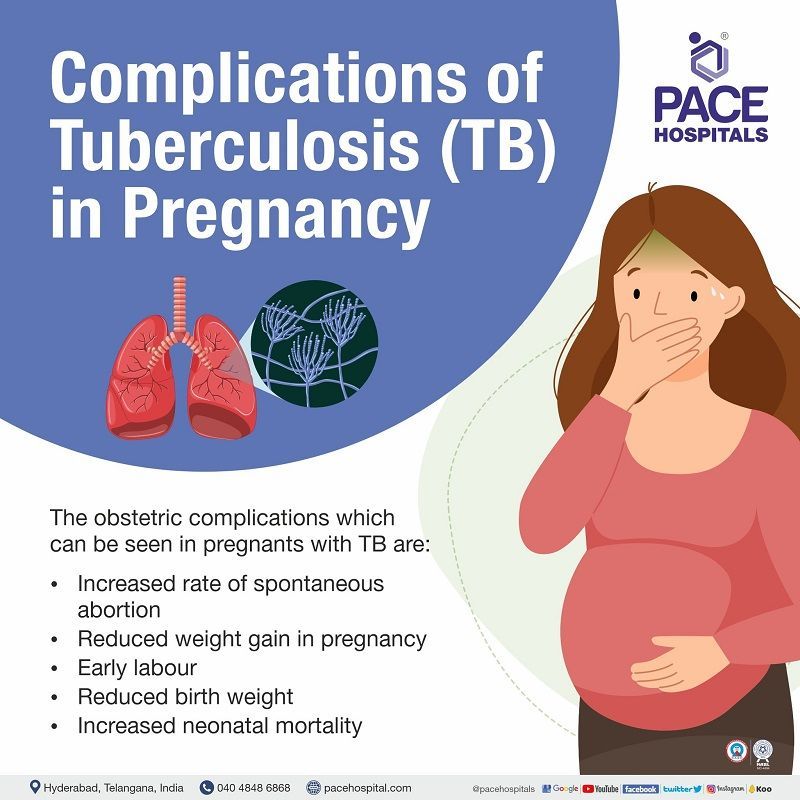
Complications of tuberculosis in pregnancy
The obstetric complications which can be seen in pregnancy include:
- Increased rate of spontaneous abortion
- Deficient weight gain in pregnancy
- Preterm labour (early labour)
- Reduced birth weight
- Increased neonatal mortality
The complications of tuberculosis in pregnancy could be exaggerated by late diagnosis by four folds, with the increased risk of preterm by nine folds.
TB - Tuberculosis Diagnosis
The definitive diagnosis of tuberculosis primarily involves detecting and isolation of Mycobacterium tuberculosis – the causative agent of tuberculosis. It can be confirmed by necessary steps such as:
- General physical examination
- Tuberculosis blood tests
- Sputum tests
- Imaging
- Bronchoscopy
- Tuberculin skin test
- Interferon-gamma release assays (IGRAs)
TB - Tuberculosis Treatment
The anti-tuberculosis drugs were developed over 40 years ago, and their optimisation is necessary to keep the drug-resistant at bay. Chemotherapy and surgery are used to treat tuberculosis disease.

Tuberculosis prevention and control
Bacillus Calmette-Guerin (BCG) is the live attenuated Mycobacterium bovis vaccine introduced in 1921 that prevents tuberculosis. It's the most common vaccination given to newborns. BCG vaccine also protects against leprosy and Buruli ulcer.
Patients with active tuberculosis need to restrict their interaction with others. Covering the mouth during laughing, sneezing, or coughing is paramount. A surgical mask must be worn when the patient is around other people, especially during the first few weeks of treatment.
Share on
Request an appointment
Fill in the appointment form or call us instantly to book a confirmed appointment with our super specialist at 04048486868

